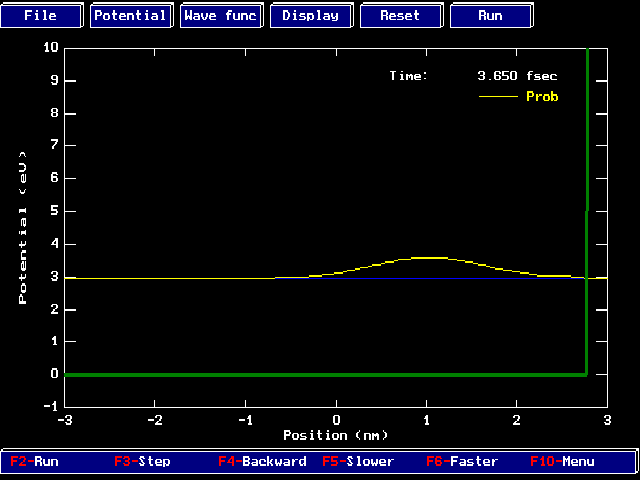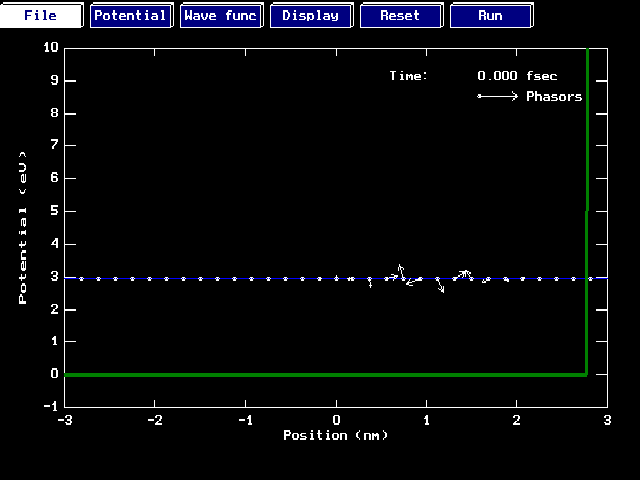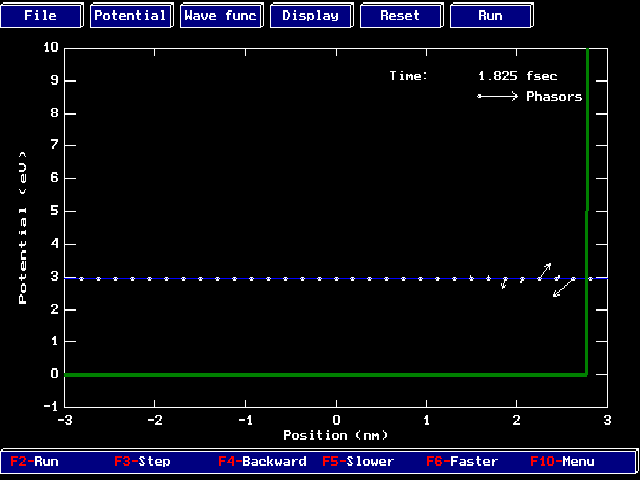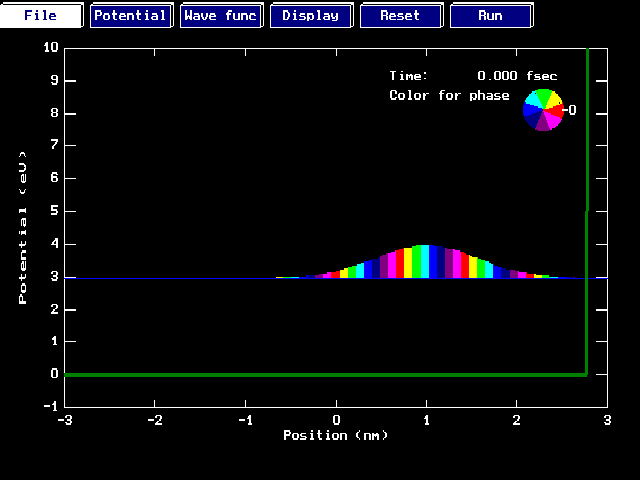
This page written by
Dan Styer,
Oberlin College Physics Department;
http://www.oberlin.edu/physics/dstyer/TeachQM/see.html;
last updated 25 January 2000.
An invited paper delivered at the winter meeting of the
American Association of Physics Teachers;
Kissimmee, Florida, 17 January 2000.
| Since the time of Heisenberg, physics students have been admonished to not even try to visualize quantum mechanics. Although this policy is not without merit, it can allow misconceptions to flourish and intuition to fade. This talk demonstrates computer and non-computer visualization techniques that can (when their limitations as well as their areas of applicability are kept in mind) improve both understanding of and problem-solving in quantum mechanics. |
It is often said that quantum mechanics cannot be understood through any sort of accessible visualization -- that it can be approached only through abstract mathematics.
This sentiment is not new. For example, in a 1926 letter to Wolfgang Pauli, Werner Heisenberg wrote that
| The more I think of the physical part of the Schrödinger theory, the more detestable I find it. What Schrödinger writes about visualization makes scarcely any sense, in other words I think it is shit. The greatest result of his theory is the calculation of matrix elements. |
Nor has this sentiment gone away. The 1993 textbook by Halliday, Resnick, and Walker tells us that
| The single electron does interfere with itself. But don't try to visualize how it does so! |
There's a lot to be said for this attitude. The quantal world is very different from our familiar world, and it is unlikely that our macroscopically-trained minds will ever be able to arrive at a perfect picture of the mechanics of the atom.
So why should we even try to visualize quantum mechanics? There are two reasons, one involving understanding and the other involving efficient calculations.
First, humans are visual animals and, even when we are told not to visualize, pictures pop into our minds unbidden. For example, many students think of a quantal particle as a small, hard ball, moving in accord with classical mechanics and possessing both a definite position and a definite momentum, but one that is moving so fast and so erratically that it appears only as a blur. (Anyone who asks "How can a particle pass through the nodes in its wavefunction?" is probably suffering from this mistaken visualization.) Told to avoid visualization, these students don't examine their mental image critically, so they hold on to this misunderstanding despite its inappropriateness. [More examples of inappropriate visualizations are presented in the article by Ambrose.]
Second, lack of a mental picture leads to inefficient problem solving. What would happen if classical mechanics students were not allowed to visualize when faced with a standard problem like tossing a ball from the top of a cliff? Many would calculate the parabolic trajectory of the ball, note that the trajectory intersects ground level twice, and never notice that the intersection behind the ball-tosser came about before the ball left the tosser's hand. Some might even calculate the trajectory as a very tight ellipse (with one focus at the center of the earth and one near the surface) and wonder why the orbit intersects the earth's surface an infinite number of times!
An embarrassing experience of this sort actually happened to me. In May 1994 I uncovered a paradox concerning time development in the infinite square well: I found a quantum revival time after which any initial wavefunction would come back to itself, but this revival time did not pass over to the classical period in any limit. This paradox gnawed at me for five and a half years until, in November 1999, I realized that the classical period was smaller that the quantum revival time. Once I got over this conceptual roadblock, I resolved the paradox in thirty minutes. The computation was not hard -- the visualization was.
Just because one isn't born with an intuition for quantum mechanics doesn't mean that one can't develop it. Everyone here knows, for example, that most students enter introductory physics courses with mindsets considerably closer to that of Aristotle than to that of Newton, yet physics teachers now possess an arsenal of tools for changing this viewpoint. The aim of this talk is to assess the much smaller number of visualization tools available for promoting conceptual understanding in quantum mechanics.
This section discusses techniques for visualizing the three central concepts of quantum mechanics: probability, interference, and entanglement. Let me warn you up front that no visualization technique is perfect: all have both strong points and drawbacks. Yet an imperfect mental picture, with its imperfections understood, is far preferable to any mental picture held uncritically. (Indeed, the mental images used throughout classical physics -- the point particle, the rigid body, the monochromatic wave -- are also imperfect models.)
"Nothing is more unfamiliar or uncongenial to the human mind than thinking correctly about probabilities", claims paleontologist Stephen Jay Gould. Perhaps true, but the concept of probability density is not more difficult in quantum mechanics than it is in any other field.
The multimedia presentation Quantum Mechanics by Kristel Michielsen and Hans De Raedt contains nice animations of a quantal probability density evolving in time through double slits.
Other software that displays probability density are my own programs
QMTime and its revision QMValue.
For example, here is a rightward moving wavepacket launched to strike the green barrier:

Some time later, the packet hits the wall.
Interference between incoming and reflected waves causes
high mounds (constructive interference)
and nodes (destructive interference):

Later still, all of the packet is moving to the left:

However, visualizing probability density alone is not adequate. Just as the position does not convey full information about a classical particle's dynamic state (one must also know the velocity), so the probability density does not convey full information about a quantum particle's wavefunction (one must also know the phase). For example, the first and third illustrations above are quite similar: there's no way to tell by looking whether the wavepacket is moving left or right.
Traditionally, the complex-valued wavefunction is shown
through plotting real and imaginary parts,
but more physically significant are the magnitude and phase.
This suggests a representation
through phasors.
This technique has been used in the
book by Richard Feynman and in the
approach of Edwin Taylor.
Here are phasor representations for the three scenes
of wavepacket development shown above.
Packet heading right:

(The phasors rotate counterclockwise as your eye travels from
left to right: the direction of motion.)
Incoming and reflected waves interfering:

(All the phasors are nearly parallel, i.e. the wavefunction displays nearly constant phase.)
And finally the reflected packet heading left:

(The phasors rotate counterclockwise as your eye travels from
right to left: the direction of motion.)
Another representation of complex values is through color.
The convention I use in my program has
"red" meaning "pure positive real",
"green" meaning "pure positive imaginary",
"blue" meaning "pure negative real", and so forth.
Here are color-for-phase representations of the same
three scenes of wavepacket development. Packet heading right:

(The colors pass from red to yellow to green and so forth
as your eye travels from left to right:
the direction of wavepacket motion.
This implies counterclockwise rotation of the corresponding
phasor -- see the reference color wheel in the upper right corner.)
Incoming and reflected waves interfering:

(Each hump is nearly pure in phase.)
And finally the reflected packet riding off into the sunset:

(The colors are now arranged in the opposite sequence.)
Although full information about the wavefunction is available through either of these visualizations, it seems to me that it is easier to decode the phase information in the color-for-phase representation. However, in the phasor representation it is clear that an up-arrow summed with an equal down-arrow should give zero, whereas in color-for-phase it is not obvious that green summed with maroon should give darkness. Both representations have the defect of investing too much physical "presence" in an abstract, non-measurable, algorithmic entity -- the wavefunction. (Wavefunction does not exist out in space the way nitrogen molecules exist out in the air of this room. Wavefunction lives in configuration space, not real space: witness that the wavefunction of a two-body system is one function in six-dimensional configuration space, not two functions in three-dimensional real space.)
In quantum theory (and as verified in nature) the results of an experiment performed at one location can correlate with the results of an independent experiment performed simultaneously far away. This feature is called "entanglement". The wonderful and almost unbelievable character of entanglement was pointed out by Einstein, Podolsky, and Rosen in 1935, but the term was coined by Schrödinger later that same year when he wrote
| I would not call that one but rather the characteristic trait of quantum mechanics...the two y-functions have become entangled. |
For example (see Griffiths), suppose a neutral pi meson decays into an electron and a positron, which fly off in opposite directions. If the vertical spin component of each product particle is measured (perhaps when both of them are five miles -- or five light-years -- from the source) then the spin of one particle will point up and the other down, but before measurement each spin was neither up or down -- they were in an entangled superposition state. (This can be verified by measuring horizontal spin components instead of vertical.)
It is through entanglement that quantum mechanics differs most dramatically from classical mechanics (and from common sense!). One must use the greatest caution in discussing entanglement, and avoid the temptation to say "an experiment performed at one location affects (or alters) the results of an independent experiment performed simultaneously far away". It is by now well-established that the connection between two such experiments is not causal and cannot be used to transmit a message. To emphasize this distinction, the strong connection between two distant events, when one is a cause and the other an effect, is called "action at a distance"; while the weak connection due to entanglement is called "passion at a distance".
In the formalism of quantum mechanics, wavefunctions of a two-body system are functions of two variables: y(x1,x2). If that wavefunction factorizes -- y(x1,x2) = yA(x1) yB(x2) -- then the state is not entangled. Otherwise it is. (Wavefunctions antisymmetric under interchange are always entangled.)
Thus a visualization of entangled wavefunctions necessarily involves one function of two variables rather than two functions of one variable. In the pi meson example, it is impossible to visualize the entangled state through some spin visualization on the right and some spin visualization on the left. The whole point is that there are "links" -- entanglements -- between the right and the left. Nor does it work to represent such links by strings or rubber bands connecting the two spin visualizations, because these suggest action at a distance rather than passion at a distance.
One possibility is to draw phasors at representative points on the two-variable plane. I'll give some examples involving spin-1/2 wavefunctions, where there are only four points in the two-variable "plane". There is a particle on the left with two basis spin states: say "up" and "down". Similarly for a particle "far away" on the right. The examples are here. (To view them, you need the free Adobe Acrobat Reader software.)
This is the best I can do for visualizing entangled states, and I think you'll agree that it's a pretty poor job. None of the magic or mystery shows up in the representation. It's even hard to tell, from looking at a representation, whether the state is entangled or not! This area particularly needs more thought and insight. I can only conclude that the reason Stephen Jay Gould finds probability so foreign is that he's never tried thinking about entanglement.
In short, a variety of visualization techniques (some better than others) can help develop correct intuition concerning the quantal world. But I am convinced through hard experience (in quantum mechanics as well as other fields) that visualization is a good place to begin developing intuition but a poor place to end it. Using a computer to produce results that are then left uninvestigated and unanalyzed can be worse than doing nothing, because it fosters an attitude of "Why think? Let the computer do it." Intuition develops from thinking about the computer's results, playing games with them, asking qualitative and quantitative questions about them, comparing the results for similar systems, building with the results in the intimate way that a potter builds with clay. Effective intuition building springs, not from a clever display alone, but from a clever display associated with well thought-out exercises and a strategy designed to facilitate investigation.
Several such strategies exist, including traditional exercises, Just-in-Time Teaching, "elicit, confront, resolve" tutorials in the tradition of McDermott et al., peer instruction in the tradition of Mazur, and interactive lecture demonstrations in the tradition of Sokoloff, et al. But I want to emphasize a strategy involving games. Anyone with pre-teen boys at home (and I have two) is astonished at how much they know about the Pokémon game. Games have proven to be effective in teaching various aspects of physics (see references from diSessa to Dugdale and Kibbey) because a well thought-out and entertaining game captivates student interest and results in students spending more time and more effective time on learning the subject.
I can think of at least two quantal games that might be effective in developing intuition (in both cases, intuition concerning the one-dimensional energy eigenproblem). The user inputs a potential -- perhaps by manipulating a graph with a mouse. The program responds with several candidates for energy eigenfunctions for that potential, only one of which is correct. The student's job is to use the qualitative characters of the candidates to select the correct one. (This would be a computerized and "mass produced" version of one of the best quantum mechanics problems ever posed, namely "Exposing an unsuccessful plot", problem 3-17 in French and Taylor.)
The other game possibility works in the opposite direction. The user inputs an initial potential, the computer makes (but does not reveal) a modification to that potential. The user is shown one of the new energy eigenstates, and challenged to find the potential that produces this state.
My conclusion? Simply that this is rewarding work and there's a lot more to be done.
Letter from Heisenberg to Pauli, 8 June 1926, quoted in Walter Moore, Schrödinger: Life and Thought (Cambridge University Press, Cambridge, UK, 1989) page 221.
D. Halliday, R. Resnick, and J. Walker, Fundamentals of Physics, extended version, fourth edition (John Wiley, New York, 1993) page 1173.
Bradley S. Ambrose, P.S. Shaffer, R.N. Steinberg, and L.C. McDermott, "An investigation of student understanding of single-slit diffraction and double-slit interference", American Journal of Physics 67 (1999) 146-155. See particularly section III.C, "Difficulties with modern physics concepts", on page 152.
Stephen Jay Gould, "Ten Thousand Acts of Kindness", in Eight Little Piggies (Norton, New York, 1993) page 280.
A. Einstein, B. Podolsky, and N. Rosen, "Can quantum-mechanical description of physical reality be considered complete?", Physical Review 47 (May 1935) 777-780.
Erwin Schrödinger, "Discussion of probability relations between separated systems", Proceedings of the Cambridge Philosophical Society 31 (October 1935) 555-563, lines 5-8.
David J. Griffiths, Introduction to Quantum Mechanics (Prentice Hall, Englewood Cliffs, NJ, 1995) Afterword.
P.G. Kwiat and L. Hardy, "The mystery of the quantum cakes", American Journal of Physics 68 (2000) 33-36.
Gregor M. Novak, Evelyn T. Patterson, Andrew D. Gavrin, and Wolfgang Christian, Just-in-Time Teaching (Prentice Hall, Upper Saddle River, NJ, 1999).
Lillian C. McDermott, Peter S. Shaffer, and the Physics Education Group, Tutorials in Introductory Physics (Prentice Hall, Upper Saddle River, NJ, 1998).
Eric Mazur, Peer Instruction (Prentice Hall, Upper Saddle River, NJ, 1997).
David R. Sokoloff and Ronald K. Thornton, "Using interactive lecture demonstrations to create an active learning environment", The Physics Teacher 35 (1997) 340-347.
Andrea diSessa, "Unlearning Aristotelian physics", Cognitive Science 6 (1982) 37-75.
Barbara White, "Designing computer games", Cognition and Instruction 1 (1984) 69-108.
Sharon Dugdale, "The design of computer-based mathematics instruction", in Computer-Assisted Instruction and Intelligent Tutoring Systems, edited by Jill Larkin and Ruth W. Chabay (Lawrence Erlbaum Associates, Publishers, Hillsdale, NJ, 1992), pages 11-45.
Tarim Biswas, "Group theory (symmetries) in a computer game", Computers in Physics 12 (1998) 488-492.
Ruth W. Chabay, computer program Electric Field Hockey (Physics Academic Software, Raleigh, NC).
David Towbridge and Bruce Sherwood, computer program EM Field 5.0 (Physics Academic Software, Raleigh, NC).
Sharon Dugdale and David Kibbey, computer program Green Globs and Graphing Equations (Sunburst Communications, Pleasantville, NY, 1997).
A.P. French and E.F. Taylor, An Introduction to Quantum Physics (Norton, New York, 1978) page 152.